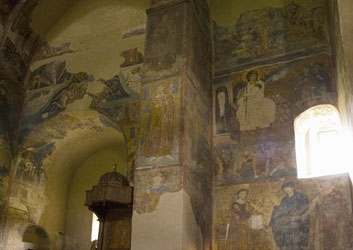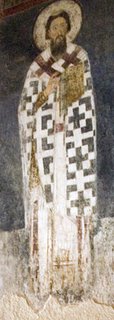When I awoke, it was still raining. Today’s destination was the Mileševa Monastery, located
 near the town of Prijepolje in southwest Serbia. obscuring the likely beautiful views of the tree-covered mountains and snaking river. In some areas, the pine trees were particularly tall. The Lim River was moving quite fast andThick clouds hung below the tips of Mt. Zlatar, seemed rather high. The road to Prijepolje was winding and narrow. I saw several bridges being constructed, eliminating at least some of the curves. Construction workers busied themselves with their cell phones rather than attending to directing traffic. Others sat along the roadside and talked. We drove through the uninspiring town of Nova Varoš and proceeded 27 km farther to Prijepolje. I was surprised to see three mosque minarets in the town, but was
near the town of Prijepolje in southwest Serbia. obscuring the likely beautiful views of the tree-covered mountains and snaking river. In some areas, the pine trees were particularly tall. The Lim River was moving quite fast andThick clouds hung below the tips of Mt. Zlatar, seemed rather high. The road to Prijepolje was winding and narrow. I saw several bridges being constructed, eliminating at least some of the curves. Construction workers busied themselves with their cell phones rather than attending to directing traffic. Others sat along the roadside and talked. We drove through the uninspiring town of Nova Varoš and proceeded 27 km farther to Prijepolje. I was surprised to see three mosque minarets in the town, but was  told that this indeed was a more Muslim area.
told that this indeed was a more Muslim area.About 6 km outside of Prijepolje was the famous Mileševa Monastery. In front of one of the buildings was a large Serbian Orthodox flag, seemingly making a political/religious statement. Around a portion of the perimeter were stone ruins of a wall and perhaps some Turkish small buildings. King Vladislav founded the monastery around 1234. Two years later, it received the body of St. Sava, elevating its position of importance to second amongst Serbian monasteries. In the 1500’s, the monastery operated a printing shop, spreading liturgical books throughout Serbia and neighboring areas. In retaliation for a Serbian uprising against the Turks in 1688, the monastery was burned and left in ruins. The present-day building dates back to 1863. We were not able to enter the monastery building. The church of the Holy Ascension was erected in 1234/5 in the style of the Raška School.
I was eager to enter the inside of the church and see its famous frescoes which represent one of the peaks of 13th century European painting. Inside, I met the Serbian/Swiss families with which I
 had shared a train car on the Šargan Eight train a day before. A nun lit candles on top of coffin over the gravesite of St. Sava. On the opposite wall was the coffin of a recently canonized individual. In the domes and around other places, frescoes had larg
had shared a train car on the Šargan Eight train a day before. A nun lit candles on top of coffin over the gravesite of St. Sava. On the opposite wall was the coffin of a recently canonized individual. In the domes and around other places, frescoes had larg e pieces missing. The frescoes of King Vladislav and St. Sava were painted during their lifetimes and are seen as some of the best (and accurate) portraits of the 13th century. In addition to the emphasis on realism, the frescoes portray the psychological characterizations of the individuals. As in most frescoes, the founder (in this case Vladislav) is depicted holding a small model of the church. Many of the figures’ eyes had been gouged or obliterated by the Turks. I heard that these may be soon restored. Frescoes depicting the Last Judgment were heavily damaged during WWII when the church was used as a stable. Scenes of the Passion Week covered large portions of the walls. The church’s most famous fresco is the White Angel, now regarded as a symbol of Serbia and recently adopted as an emblem for the United Nations. Around the angel are other portions of the Easter story and Resurrection. Remnants of a fresco once covering the scene leads one to speculate that angel with its enigmatic smile might not be with us today if it were not for such preservation.
e pieces missing. The frescoes of King Vladislav and St. Sava were painted during their lifetimes and are seen as some of the best (and accurate) portraits of the 13th century. In addition to the emphasis on realism, the frescoes portray the psychological characterizations of the individuals. As in most frescoes, the founder (in this case Vladislav) is depicted holding a small model of the church. Many of the figures’ eyes had been gouged or obliterated by the Turks. I heard that these may be soon restored. Frescoes depicting the Last Judgment were heavily damaged during WWII when the church was used as a stable. Scenes of the Passion Week covered large portions of the walls. The church’s most famous fresco is the White Angel, now regarded as a symbol of Serbia and recently adopted as an emblem for the United Nations. Around the angel are other portions of the Easter story and Resurrection. Remnants of a fresco once covering the scene leads one to speculate that angel with its enigmatic smile might not be with us today if it were not for such preservation.Outside once again, we headed through an archway and walked on top of a bridge reconstructed in the original Turkish style. I am glad to see such preservation and restoration beginning to occur. Surrounding the area were fields of fruit trees. Goats happily nibbled away on the tall grasses. After a drink at the local café, we headed back to Zlatibor. Rain followed us.
No comments:
Post a Comment